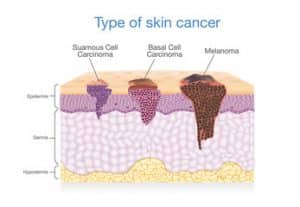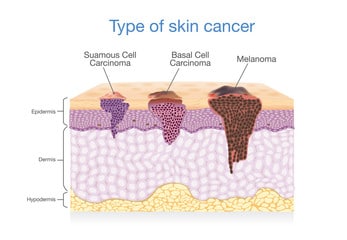Customized Exercise Programming – Melanoma
 John received a referral for a client with stage III melanoma on his right thigh with brain metastases. John’s a Corrective Exercise Specialist but has worked mostly with orthopedic patients. He recently became a Cancer Exercise Specialist and asked if he could hire me to help him with and teach him how to put together Ralph’s exercise program. He completed his initial assessment and health history and shared the following information with me:
John received a referral for a client with stage III melanoma on his right thigh with brain metastases. John’s a Corrective Exercise Specialist but has worked mostly with orthopedic patients. He recently became a Cancer Exercise Specialist and asked if he could hire me to help him with and teach him how to put together Ralph’s exercise program. He completed his initial assessment and health history and shared the following information with me:
- Ralph is 57 years old and an active outdoorsman prior to his cancer diagnosis
- Ralph is 6’3 and currently 188 lbs. He has 10% bodyfat
- Ralph skis and snowshoes in the winter and hikes, bikes, and paddle boards in the summer. Prior to his cancer diagnosis he did push-ups, pull-ups, dips, and crunches twice a week.
- He was diagnosed in September 2019.
- He underwent a wide surgical excision with a pelvic lymph node dissection (20 nodes removed) in October 2019. In January 2019 he underwent stereotactic radiosurgery with the Gamma Knife. He is currently undergoing radiation to his pelvis and will be done at the end of July.
- He is on targeted therapy with a BRAF inhibitor – Vemurafenib (Zelboraf)
- His BP is 110/60 and his RHR is 58
- He has extreme fatigue and joint pain and has been told to avoid the sun for the unforeseen future
- He has slight lymphedema in his right groin area
Postural Assessment:
- Moderate upper-crossed syndrome
- Forward flexed at the hips (large vertical incision in right thigh)
- Right knee medially rotated
- He meets the 90% requirement in all planes of motion so there is no reason she can’t begin upper-body weight training.
- Soon after his Gamma Knife he started to notice problems with his coordination and balance. He was too unstable to perform the balance test or squat test.
- His gait is “wobbly” and unstable
I started by compiling my own notes and breaking everything down for John one step at a time.
- Because Ralph has lymphedema in the right side of his pelvic area, John will begin every session with a five-minute upper body ergometer workout. This will allow Ralph to effectively warm-up his body in preparation for exercise without putting any more stress on his lower body. It is also safer for him while he works to improve his balance and coordination. He will make sure that Ralph stays hydrated, exercises in a cool environment, doesn’t wear restrictive clothing on his lower body, and doesn’t overheat. Following his warm-up John will have him begin with upper body lymph drainage exercises and follow with lower body lymph drainage exercises. Ralph will begin with 1/2 hour sessions. John will need to make sure that Ralph feels more energy (rather than being exhausted) following each workout. John will allow time in between exercises and ask Ralph how he is feeling every few minutes. If he appears to be struggling, he will have him perform deep breathing exercises and do some assisted stretching. If there is an increase in girth measurements in his lower body (particularly his ride side), it may mean that they are doing too much too fast. Therefore, they will progress very slowly to see what his lymphatic system can handle. He may begin performing strength training for his upper body with special attention being paid to stretching his chest and strengthening his upper back. Not only will this help to correct his posture, releasing tension in his chest area may also help to improve the flow of lymphatic fluid.
- Because he has difficulty with balancing and gait, John will incorporate a balance progression. This will minimize the risk of falling and potential injury. As Ralph’s balance improves, John can begin to try things like a foam roller, balance discs, or the BOSU® Balance Trainer.
- Because of the upper-crossed syndrome, Ralph needs to stretch both his pecs and lats. He should focus on shoulder retraction and depression to stabilize his shoulder girdle. John will start by having Ralph lie supine and reach his arms and legs in opposite directions to stretch his abdomen. This will help to improve his posture (forward hip flexion) and lymphatic drainage in the groin area. If Ralph can do that with no pain, he will progress to the top of a BOSU(R) Balance Trainer. To strengthen his opposing low back muscles and pelvic floor muscles, he will start with pelvic tilts and modified bridges. John will make sure that Ralph slowly progress toward the end movement where his glutes are contracted and his thighs are stretching do to his incision. Enough time has passed that the doctor has given him medical clearance to do leg exercises, but John wants to make sure not to do too much too fast and cause Ralph to have an increase in pain and fatigue. John has to be careful to not have him do too much weight-bearing on his legs because of the lymphedema. They will both keep an eye out for an increase in swelling which would suggest they were doing too much and they would need to back off a bit. If he can tolerate it, Ralph might start with one or two reps of “bird dog.” If he can do this with no pain, it may help with balance, core, and coordination. Ralph’s goal is to get back to his sports by this coming winter. Right now, this would be ill-advised with his lymphedema and balance issues. John will teach Ralph some safe yoga moves that, if done consistently, may help to improve him to improve bone density as well as balance.
- After John completed the Modified Thomas Test on Ralph he was able to determine that his right adductors and quads are tight. Therefore, he would need to focus on hip abduction and avoid hip adduction-type exercises on the left leg and focus on stretching the quads while strengthening the hamstrings. He will need to avoid using exercise bands or having her perform any type of exercise that applies too much pressure to the legs because she does not want to interfere with circulations that could ultimately lead to an increase in swelling. They will begin with body-weight exercises like partial wall squats and heel supine heel slides; starting with just a few repetitions and seeing what he can tolerate. If he is having a very low-energy day they will skip the leg exercises.
- John wants to get Ralph in a swimming pool ASAP. He knows that the hydrostatic pressure of the water will be great for his lymphedema and he can get him walking/jogging in the water and beginning to do laps as well. He also knows that all of the radiation can have a negative effect on Ralph’s heart and lungs and this will be a great way to improve cardiovascular conditioning without added stress on his legs.
Once I gathered my thoughts, I was able to come up with the following workout routine for John to facilitate with Ralph for his initial 6-8 weeks.
DAILY lymph drainage exercises. These should be done before and after exercise sessions (can be done more often if desired). He can do crunches once she can stand erect without forward hip flexion. He can do a few more pelvic tilts or focus on deep belly breathing for now. Ralph will either walk with a cane or use the upper body ergometer for 5 minutes a day, working up to 20-30 minutes each day as tolerated. If his energy is really low, he can break this into 5-10 minute increments (or whatever he can do without becoming more fatigued). Done properly, Ralph should feel energized. Each cardio session should end with lymph drainage exercises. If there is no increase in swelling, Ralph may increase either intensity or duration – in very small increments. He should not wear tight fitting clothing on his lower body or exercise in very hot/humid temperatures. He should also stay well-hydrated. If at any point there is an increase in girth measurements, John will instruct Ralph to return to the level of intensity and duration that he was at prior to the increase in swelling. John also recommends that Ralph work on his balance progression several times per day.
2 x PER WEEK Lower-body strength training – starting with functional training. John will place his hand gently on the lateral side of Ralph’s left knee and instruct him to do squats while gently pushing laterally against his hand. They will aim for 3-5 but stop if Ralph gets too fatigued. John will have him do clams on each side. He will place a pillow under his head and make sure his spine is in alignment. They will aim for 3-5 reps. on each side. Fatigue will be the determining factor for both reps and resistance as they progress. John needs to make sure that whatever they do gives Ralph more energy rather than causing him to be more fatigued as well as making sure there is no additional swelling in his groin/leg.
On two of the non-leg days Ralph will do exercises to stretch the chest and lats, head retractions (forward head), and adductor stretches. He will begin with reverse flys using a yellow band and sitting on an upright bench. John will teach him how to stabilize his shoulder girdle and engage his core while performing 5-6 reps with his palms facing the ceiling (this will help with scapular stabilization and strengthening) to begin with. He will have him lie supine with his knees bent and start him with 2 lb.
weights for chest flys. He will start with 5-6 reps and work on his form. They will add reps and resistance as Ralph’s energy level and strength increases.
He will do one private yoga class at his discretion each week and try to get to the pool once or twice.
John will re-assess Ralph in 8 weeks and either continue with this routine, or progress to longer duration of cardio, more repetitions, and the addition of more strength training exercises. He will begin to incorporate supine planks with Ralph’s feet on the physioball, progressing towards leg curls. His hamstrings are over stretched and week.
If you are in need of assistance with a special-needs or physically-challenged client, you can get Andrea Leonard’s help in with custom exercise programming

